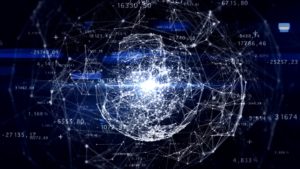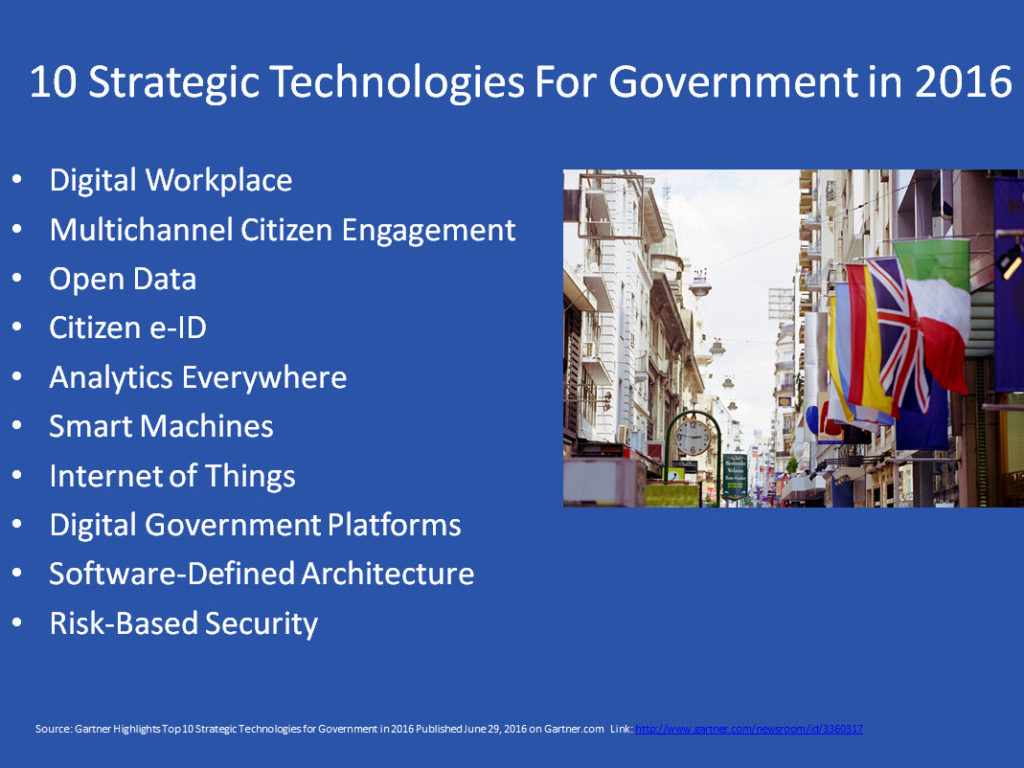
“The top ten strategic technologies for Government include the following”
 Digital Workplace – Strengthening collaboration within and across government agencies using cloud-based analytics, social and mobile platforms that enable a more data-driven work environment is critical for governments to stay in step with citizens’ needs. Attracting and retaining top talent in the under-age-30 workforce is going to be a challenge for governments globally as well. By adopting a more progressive mindset of using technologies to attain greater autonomy, mastery, and purpose, governments can improve productivity and employee retention.
Digital Workplace – Strengthening collaboration within and across government agencies using cloud-based analytics, social and mobile platforms that enable a more data-driven work environment is critical for governments to stay in step with citizens’ needs. Attracting and retaining top talent in the under-age-30 workforce is going to be a challenge for governments globally as well. By adopting a more progressive mindset of using technologies to attain greater autonomy, mastery, and purpose, governments can improve productivity and employee retention.
Multichannel Citizen Engagement – Capitalizing on the lessons learned from industry leaders including Disney, Virgin Atlantic, REI and others who have world-class multichannel and omnichannel management operations today, global governments need to begin their journey of defining more effective citizen engagement strategies. Gartner mentions that analytics and measuring citizen outcomes is essential as mile markers on this journey. There’s also the need to build in the flexibility of sending the right messages through the right channels at the right time to best serve constituents.
Open Data – By definition, open data is accessible to the public through a variety of access technologies, the most efficient and scalable being open, published Application Programmer Interfaces (APIs). Examples of open data initiatives include the Global Open Data Index, which is operated and maintained by Open Knowledge International; DataUSA, which relies on data analytics and visualization; and the European Union’s Open Data Portal that includes data visualization applications.
Citizen e-ID – Gartner defines citizen electronic identification (e-ID) as the orchestrated set of processes and technologies managed by governments to provide a secure domain to enable citizens to access these core resources or services. Enterprise-wide authentication technologies including biometrics are rapidly changing this area of IT investment by leading governments globally.
Analytics Everywhere –. Analytics Everywhere is an initiative that seeks to capitalize on all available data including structured, unstructured and real-time data feeds from Internet of Things (IoT) sensors and devices. Gartner predicts that Analytics Everywhere initiatives will move governments beyond using dashboards and scorecards that reflect the past and instead focus on using machine learning to predict optimal outcomes of their strategy decisions. Inherent in Analytics Everywhere platforms is the ability to make more effective use of Business Intelligence (BI) and attain contextual intelligence of operations based on real-time data, leading to more effective decisions.
Smart Machines – Integrating machines capable of adapting their behavior based on patterns and predictions in data, then determining the optimal decision based on constraints has the potential to redefine how effective governmentsLike private industry, governments have the potential to use smart machines to define entirely new business models and methods of delivering services. Germany’s thought leadership and examples of how Industrie 4.0 can streamline manufacturing and become the global language of production is gaining momentum today. The following graphic explains how the initiative is enabling greater levels of manufacturing intelligence and process synchronization:
Internet of Things – The U.S. federal government spent almost $35B on Internet of Things (IoT) solutions from the fiscal year 2011 through the fiscal year 2015 according to a recent Business Insider post. Governments have the potential to create entirely new services that better align with citizen’s needs by capitalizing on the insights gained from a network of sensors on fixed and mobile objects. IoT platforms also have the potential to monitor transportation systems and determine which improvements will deliver the greatest benefit. Combining commercial and government IoT data can lead to step-wise gains in how businesses and governments collaborate to solve the toughest challenges each face in serving customers and citizens.
Digital Government Platforms – Orchestrating transactions, payments, identity management and verifications, financial services and support programs across multiple agencies and globally across governments are catalysts driving the development of digital government platforms.
Software-Defined Architecture – For many governments, migrating to a Software-Defined Architecture (SDA) is a must-have for the future. SDAs act as an intermediary between the requester and the provider of a service so that the service can be more agile and adaptable to changing requirements. Getting beyond the constraints of legacy IT platforms and infrastructures to get the most value out of Analytics Everywhere, IoT, and smart machines make SDAs an essential technology for governments in
Risk-Based Security – Using advanced algorithms to anticipate security risks, gaining greater visibility into the dimensions of risk, and having a security platform that can scale fast and securely are all aspects of risk-based security technologies. Gaining this level of insight and security intelligence, accentuated with advanced algorithms can predict risk, are giving CIOs and their team predictive insight into which areas of security to prioritise and act on.
Source:www.gartner.com


















